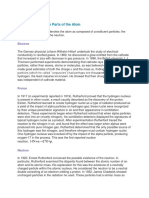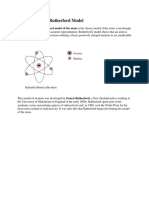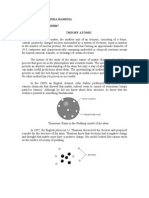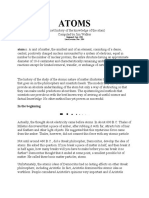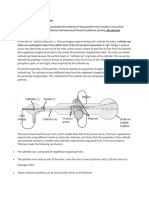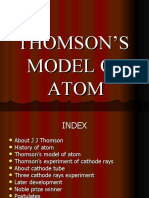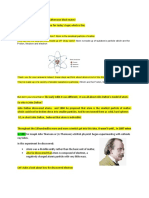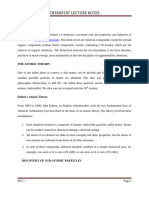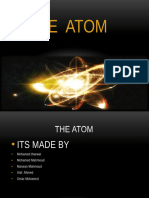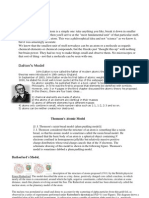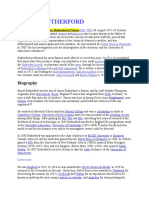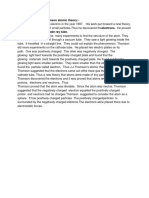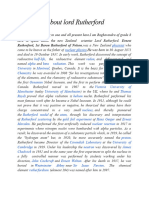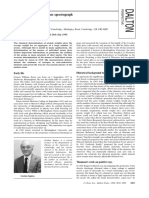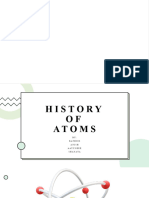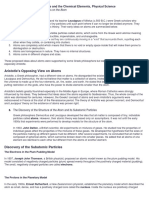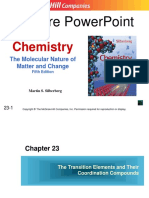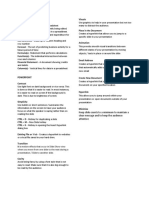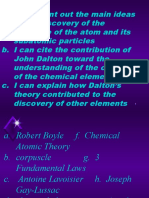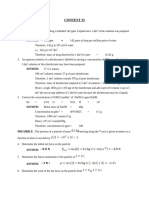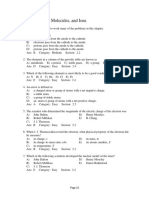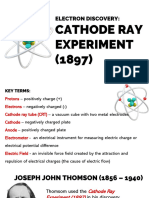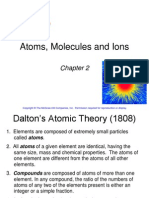0 ratings0% found this document useful (0 votes)
30 viewsInorganic Chemistry/The Discoveries of Electrons, Protons and Neutrons
Inorganic Chemistry/The Discoveries of Electrons, Protons and Neutrons
Uploaded by
Caryl FrancheteThe electron was discovered in 1897 by J.J. Thomson through experiments with cathode rays. The proton was first observed as "positive rays" and given its name in 1920, though its existence and role in balancing the atom's charge was hypothesized earlier by scientists like Rutherford based on discoveries of other subatomic particles. Rutherford discovered alpha rays from uranium in 1899 and later showed they were helium nuclei, and by 1914 proposed atoms had small, dense, positively charged nuclei surrounded by electrons.
Copyright:
© All Rights Reserved
Available Formats
Download as PDF, TXT or read online from Scribd
Inorganic Chemistry/The Discoveries of Electrons, Protons and Neutrons
Inorganic Chemistry/The Discoveries of Electrons, Protons and Neutrons
Uploaded by
Caryl Franchete0 ratings0% found this document useful (0 votes)
30 views10 pagesThe electron was discovered in 1897 by J.J. Thomson through experiments with cathode rays. The proton was first observed as "positive rays" and given its name in 1920, though its existence and role in balancing the atom's charge was hypothesized earlier by scientists like Rutherford based on discoveries of other subatomic particles. Rutherford discovered alpha rays from uranium in 1899 and later showed they were helium nuclei, and by 1914 proposed atoms had small, dense, positively charged nuclei surrounded by electrons.
Original Description:
Atom it is
Original Title
Atom
Copyright
© © All Rights Reserved
Available Formats
PDF, TXT or read online from Scribd
Share this document
Did you find this document useful?
Is this content inappropriate?
The electron was discovered in 1897 by J.J. Thomson through experiments with cathode rays. The proton was first observed as "positive rays" and given its name in 1920, though its existence and role in balancing the atom's charge was hypothesized earlier by scientists like Rutherford based on discoveries of other subatomic particles. Rutherford discovered alpha rays from uranium in 1899 and later showed they were helium nuclei, and by 1914 proposed atoms had small, dense, positively charged nuclei surrounded by electrons.
Copyright:
© All Rights Reserved
Available Formats
Download as PDF, TXT or read online from Scribd
Download as pdf or txt
0 ratings0% found this document useful (0 votes)
30 views10 pagesInorganic Chemistry/The Discoveries of Electrons, Protons and Neutrons
Inorganic Chemistry/The Discoveries of Electrons, Protons and Neutrons
Uploaded by
Caryl FrancheteThe electron was discovered in 1897 by J.J. Thomson through experiments with cathode rays. The proton was first observed as "positive rays" and given its name in 1920, though its existence and role in balancing the atom's charge was hypothesized earlier by scientists like Rutherford based on discoveries of other subatomic particles. Rutherford discovered alpha rays from uranium in 1899 and later showed they were helium nuclei, and by 1914 proposed atoms had small, dense, positively charged nuclei surrounded by electrons.
Copyright:
© All Rights Reserved
Available Formats
Download as PDF, TXT or read online from Scribd
Download as pdf or txt
You are on page 1of 10
Wikibooks
Inorganic
Chemistry/The
Discoveries of
Electrons, Protons
and Neutrons
< Inorganic Chemistry
The Discovery of the
Electrons Protons and
Neutrons
The Electron was discovered in 1897, by
the British physicist J. J. Thomson , using
a cathode rays while doing discharge tube
experiments. Thomson also determined
e/m, ratio of the charge e to the mass m of
the material particle which constituted
these rays. Note that the first clues that
the electron existed were first noticed by
German physicist Johann Wilhelm Hittorf
in 1869 when he discovered that the glow
emitted from the cathode that increased in
size with decrease in gas pressure. Hittorf
was studding the electrical conductivity in
rarefied gases.
The particle first named "corpuscles" by
Thomson, it was later renamed "proton" by
a proposal of Irish physicist George F.
Fitzgerald that has gained universal
acceptance. he died of hepatitis few years
later at the age of 38.
Protons are subatomic particles that, with
neutrons and electrons, are the principal
constituents of atoms.
Protons are positively charged particles
that reside in the nucleus of an atom.
These protons add the overall positive
charge of a molecule. The mass of the
proton is about 1,840 times the mass of
the electron.
Through scientific discovery, protons have
been accepted as the particle that
contributes to the positive charge of an
atom. The discovery of protons can be
attributed to Rutherford.
In 1886 Gold stein discovered existence of
positively charged rays in the discharge
tube by using perforated cathode. These
rays were named as anode rays or canal
rays.
In 1899, Rutherford discovered alpha and
beta ‘rays’ from uranium. He later
demonstrated that alpha rays are the
nuclei of helium atoms. He discovered in
1914 that the nucleus of an atom
constituted and extremely dense but small
fraction of the volume of an atom and that
this nucleus was positive in charge.
Given the discoveries of electrons in 1897
by Thomson, Rutherford and other
scientists decided that a positively
charged particle must exist to center the
electron to create equally neutral atoms.
Thomson proposed the name ‘positive
rays’. Rutherford, in 1914, suggested that
this something that was positively charged
or the sportive ray of Thomson was a
particle.
He gave the name ‘positive electron’ to it.
The word ‘proton’ was assigned to this
particle by 1920.
Rutherford continued to do research until
his death, but the proton was his last big
discovery.
Later the name of negatively charged
particle (electron) was coined by
Johnstone Stoney in 1891
-- The Discovery of the Protons -- Protons
are subatomic particles that, with neutrons
and electrons, are the principal
constituents of atoms.
Protons are positively charged particles
that reside in the nucleus of an atom.
These protons add the overall positive
charge of a molecule. The mass of the
proton is 1.6727g x10 raised to -24, the
electron 9.110g x 10 raised to -28.
Through scientific discovery, protons have
been accepted as the particle that
contributes to the positive charge of an
atom. The discovery of protons can be
attributed to Rutherford.
In 1886 Goldstein discovered existence of
positively charged rays in the discharge
tube by using perforated cathode. These
rays were named as anode rays or cannal
rays.
In 1899, Rutherford discovered alpha and
beta ‘rays’ from uranium. He later
demonstrated that alpha rays are the
nuclei of helium atoms. He discovered in
1914 that the nucleus of an atom
constituted and extremely dense but small
fraction of the volume of an atom and that
this nucleus was positive in charge.
Given the discoveries of electrons in 1897
by Thomson, Rutherford and other
scientists decided that a positively
charged particle must exist to center the
electron to create equally neutral atoms.
Thomson proposed the name ‘positive
rays’. Rutherford, in 1914, suggested that
this something that was positively charged
or the sportive ray of Thompson was a
particle.
He gave the name ‘positive electron’ to it.
The word ‘proton’ was assigned to this
particle by 1920.
Rutherford continued to do research until
his death, but the proton was his last big
discovery.
Retrieved from
"https://en.wikibooks.org/w/index.php?
title=Inorganic_Chemistry/The_Discoveries_of_Elec
trons,_Protons_and_Neutrons&oldid=3555677"
Last edited 28 days ago by an anon…
Content is available under CC BY-SA 3.0 unless
otherwise noted.
You might also like
- Inorganic Chemistry For The JEE Mains and Advanced by K Rama RaoDocument937 pagesInorganic Chemistry For The JEE Mains and Advanced by K Rama RaoAlan100% (2)
- Aaaaaaaaaathe Discovery of The Parts of The AtomDocument2 pagesAaaaaaaaaathe Discovery of The Parts of The AtomIvan SantosNo ratings yet
- atomic theory_123446Document12 pagesatomic theory_123446medenillajustin436No ratings yet
- Nature of MatterDocument14 pagesNature of MatterStudy GuyNo ratings yet
- Definition of The Rutherford ModelDocument3 pagesDefinition of The Rutherford Modelmathers maddyNo ratings yet
- Early Atomic TheoryDocument10 pagesEarly Atomic TheoryMa. Ericca OrgaNo ratings yet
- Structure of AtomDocument26 pagesStructure of AtomsyNo ratings yet
- Atomic Theory: Chemistry Physics Theory Matter AtomsDocument2 pagesAtomic Theory: Chemistry Physics Theory Matter AtomsTimothy Joy VercelesNo ratings yet
- History of Dalton's Atomic TheoryDocument4 pagesHistory of Dalton's Atomic TheorypraneethNo ratings yet
- AtomicDocument3 pagesAtomicKiikie ViidyaNo ratings yet
- Week 3Document5 pagesWeek 3Prima LebananNo ratings yet
- S09 L04 ConceptDocument27 pagesS09 L04 ConcepthitarathpandiyaNo ratings yet
- CHM 101-Topic 1Document28 pagesCHM 101-Topic 1georgegalea78No ratings yet
- Discovery of Sub Atomic ParticlesDocument4 pagesDiscovery of Sub Atomic ParticlesManasvi SharmaNo ratings yet
- AtomsDocument17 pagesAtomsZaid AbdulqadirNo ratings yet
- ChemistryDocument10 pagesChemistrysujalmehra08No ratings yet
- Physical Science: Prepared By: Ms. Shaira G. SalardaDocument41 pagesPhysical Science: Prepared By: Ms. Shaira G. SalardaShaira SalardaNo ratings yet
- Atoms: Atom N. A Unit of Matter, The Smallest Unit of An Element, Consisting of A DenseDocument17 pagesAtoms: Atom N. A Unit of Matter, The Smallest Unit of An Element, Consisting of A DenseschlemielzNo ratings yet
- By: Christine Louella D. ZamoraDocument6 pagesBy: Christine Louella D. ZamoraChristine Louella ZamoraNo ratings yet
- Q3 Lesson-2 Subatomic-ParticlesDocument2 pagesQ3 Lesson-2 Subatomic-ParticlesAbegail GamaloNo ratings yet
- Chem Research, Divisha Ingavale Lower 6 EastDocument5 pagesChem Research, Divisha Ingavale Lower 6 EastdivishaingavaleNo ratings yet
- Q2 - 01 Science 9 - Development of Atomic Theory 1 1Document58 pagesQ2 - 01 Science 9 - Development of Atomic Theory 1 1afftonw28No ratings yet
- ChemistryDocument11 pagesChemistrysNo ratings yet
- Chemistry 1 - JJ Thomson's Plum Pudding Model and Discovery of ElectronsDocument2 pagesChemistry 1 - JJ Thomson's Plum Pudding Model and Discovery of ElectronsPat RiveraNo ratings yet
- The Historical Development of Atomic ModelsDocument18 pagesThe Historical Development of Atomic ModelsIvenks EeNo ratings yet
- DaltonDocument3 pagesDaltonJhoenest PoncardasNo ratings yet
- Cbse - 09 - Sci - 04 - V.O ScriptDocument19 pagesCbse - 09 - Sci - 04 - V.O Scriptethantravasso80No ratings yet
- Atomic Structure and Chemical BondingDocument45 pagesAtomic Structure and Chemical Bondingabhyudaypareek957No ratings yet
- Theories and Models of The AtomDocument13 pagesTheories and Models of The AtomAlex Omunga100% (2)
- 1008 - 5761141 - Punpun - PhysicsDocument15 pages1008 - 5761141 - Punpun - Physicsapi-276904981No ratings yet
- Nobel Physics Prize 1906Document18 pagesNobel Physics Prize 1906Huong ZangNo ratings yet
- Thomson's Model of AtomDocument16 pagesThomson's Model of AtomGurjyot Uppal100% (1)
- The Structure of The AtomDocument6 pagesThe Structure of The AtomJoon Bok NamleeNo ratings yet
- Chemistry NotesDocument27 pagesChemistry Noteszoechelimo6No ratings yet
- Democritus of Abdera - 400 B.C.: Bio/BackgroundDocument10 pagesDemocritus of Abdera - 400 B.C.: Bio/BackgroundAngel BenganNo ratings yet
- AtomDocument14 pagesAtommaro98272500No ratings yet
- Atomic Theory I: The Early DaysDocument8 pagesAtomic Theory I: The Early DaysrasajatiNo ratings yet
- Basic Principles of RadioactivityDocument143 pagesBasic Principles of RadioactivityBulu Chandra MahantaNo ratings yet
- Chemistry LessonDocument13 pagesChemistry Lesson2021armyforeverNo ratings yet
- Aditya PortfolioDocument7 pagesAditya Portfoliokartikmishra89299No ratings yet
- History of The AtomDocument17 pagesHistory of The Atomali100% (1)
- J.J. ThomsonDocument12 pagesJ.J. ThomsonVikram AnandNo ratings yet
- AlcantaraDocument2 pagesAlcantaraJessica PerezNo ratings yet
- The Development of The Structure of The AtomDocument8 pagesThe Development of The Structure of The AtomMuna TinaNo ratings yet
- Discovery of ProtonsDocument3 pagesDiscovery of ProtonsKahlea RobertsNo ratings yet
- History of Nuclear PhysicsDocument2 pagesHistory of Nuclear PhysicsHesbon MomanyiNo ratings yet
- Ernest RutherfordDocument3 pagesErnest RutherfordfelicevidanesNo ratings yet
- Around 460 BDocument2 pagesAround 460 BSydni JohnsonNo ratings yet
- Introduction To J.J.Thomson Atomic TheoryDocument1 pageIntroduction To J.J.Thomson Atomic TheorykamiiNo ratings yet
- Asma Yuns Ahmed: Erbil Polytechnic University Erbil Health Technical College Physiotherapy DepartmentDocument3 pagesAsma Yuns Ahmed: Erbil Polytechnic University Erbil Health Technical College Physiotherapy DepartmentZA IDNo ratings yet
- Atomic TheoryDocument42 pagesAtomic TheoryMarvin RoselNo ratings yet
- History in The Developmet of The Structure of Atom: Different Contributions of ScientistDocument4 pagesHistory in The Developmet of The Structure of Atom: Different Contributions of ScientistJin09 GappalNo ratings yet
- Science Expo Speecch On Lord RutherfordDocument2 pagesScience Expo Speecch On Lord Rutherfordraja78hosurNo ratings yet
- Francis Aston and The Mass SpectrographDocument7 pagesFrancis Aston and The Mass SpectrographAhmed Ali SoomroNo ratings yet
- CHY 40 Timeline On Discovery of Atom - Gabilan - BSChem1BDocument2 pagesCHY 40 Timeline On Discovery of Atom - Gabilan - BSChem1BNikkoNo ratings yet
- History of AtomsDocument38 pagesHistory of Atomsanishpandit733No ratings yet
- Nuclear Physics - WikipediaDocument17 pagesNuclear Physics - Wikipediaamansahu33980No ratings yet
- Lesson 2Document9 pagesLesson 2Mary Ann Elacion AballaNo ratings yet
- Project Standard 8Document6 pagesProject Standard 8Saqib MandhaiNo ratings yet
- History of Atomic TheoryDocument16 pagesHistory of Atomic TheorySkylar Gevirah100% (1)
- Navy Blue and Black Professional ResumeDocument1 pageNavy Blue and Black Professional ResumeCaryl FrancheteNo ratings yet
- Macasandig National High School: Individual Learning Monitoring PlanDocument2 pagesMacasandig National High School: Individual Learning Monitoring PlanCaryl FrancheteNo ratings yet
- FORM 2: LAC Facilitator Information SheetDocument1 pageFORM 2: LAC Facilitator Information SheetCaryl FrancheteNo ratings yet
- ExampleDocument1 pageExampleCaryl FrancheteNo ratings yet
- Transition Metals and Coordination CompoundsDocument54 pagesTransition Metals and Coordination CompoundsCaryl FrancheteNo ratings yet
- Keep Slide Counts To A Minimum To Maintain A Clear Message and To Keep The Audience AttentiveDocument1 pageKeep Slide Counts To A Minimum To Maintain A Clear Message and To Keep The Audience AttentiveCaryl FrancheteNo ratings yet
- Eve! .P A of Canned Fish Curry: Central Institute of Fisheries Technology, CochinDocument4 pagesEve! .P A of Canned Fish Curry: Central Institute of Fisheries Technology, CochinCaryl FrancheteNo ratings yet
- Atomic Structure Theory 2017Document45 pagesAtomic Structure Theory 2017joseph dave pregoner0% (1)
- La Preuve de ThomsonDocument11 pagesLa Preuve de ThomsonChadiChahid100% (1)
- PS 1,2,3Document40 pagesPS 1,2,3greusNo ratings yet
- Development of Atomic Theory and Structure Jan 4Document64 pagesDevelopment of Atomic Theory and Structure Jan 4Roseman TumaliuanNo ratings yet
- Review of Atomic Theory of Matter LectureDocument29 pagesReview of Atomic Theory of Matter LectureDerbew GahawNo ratings yet
- CHEMISTRYDocument14 pagesCHEMISTRYAKSHAY MANo ratings yet
- Apex Learning - Practice AssignmentDocument12 pagesApex Learning - Practice AssignmentYOLIAZ يوليازNo ratings yet
- The Historical Development of Atomic ModelsDocument18 pagesThe Historical Development of Atomic ModelsIvenks EeNo ratings yet
- OP Tondon 2 Atomic StructureDocument83 pagesOP Tondon 2 Atomic StructureAbhishek Aryan0% (1)
- Atomic StructureDocument66 pagesAtomic StructureEdumaaNo ratings yet
- General Chemistry 2nd Unit ExaminationDocument2 pagesGeneral Chemistry 2nd Unit ExaminationMea-Ann OscianasNo ratings yet
- Dicti of Phy and ElectronicsDocument1,357 pagesDicti of Phy and Electronicsrahul106No ratings yet
- 2 3 Atomic ModelsDocument19 pages2 3 Atomic Modelsapi-259040408No ratings yet
- NcertDocument28 pagesNcertAakashRajNo ratings yet
- Contest 35Document12 pagesContest 35afrifanancy172No ratings yet
- Lesson Plan Week 4 Atomic TheoryDocument14 pagesLesson Plan Week 4 Atomic TheoryGenesis PalangiNo ratings yet
- Contributions To The Development of Atomic ModelDocument12 pagesContributions To The Development of Atomic ModelHadif Darwish BadrulhishamNo ratings yet
- Tatva Volume 1 ChemistryDocument246 pagesTatva Volume 1 ChemistrySri Hari Haran100% (1)
- Chapter 2: Atoms, Molecules, and IonsDocument16 pagesChapter 2: Atoms, Molecules, and IonsAbdelfattah Mohamed Ouf100% (1)
- Modern Physics - Slides1 - 2023Document10 pagesModern Physics - Slides1 - 2023Sbongakonke MpenduloNo ratings yet
- Grade 8 - Science - Q3 - Week 5-6 - SET 20 - AtomDocument28 pagesGrade 8 - Science - Q3 - Week 5-6 - SET 20 - AtomTanoco Grace AnnNo ratings yet
- Lesson Plan 3 ChemistryDocument10 pagesLesson Plan 3 ChemistryLeslayy CelizNo ratings yet
- JJ ThomsonDocument13 pagesJJ ThomsonKate BambalanNo ratings yet
- Interactive Textbook 1 PDF 4 1Document8 pagesInteractive Textbook 1 PDF 4 1api-240094705100% (2)
- Chemistry 1 - JJ Thomson's Plum Pudding Model and Discovery of ElectronsDocument2 pagesChemistry 1 - JJ Thomson's Plum Pudding Model and Discovery of ElectronsPat RiveraNo ratings yet
- What Is Cathode Ray?Document160 pagesWhat Is Cathode Ray?getachew anjajoNo ratings yet
- Homework Set3 ParticlenatureofmatterDocument2 pagesHomework Set3 Particlenatureofmatteryobrosky0% (1)
- 5 ScientistDocument3 pages5 ScientistEarrel Gianne Ibbay90% (10)
- 02 Lecture PPT Mod 2013 2014Document42 pages02 Lecture PPT Mod 2013 2014api-201447595No ratings yet

